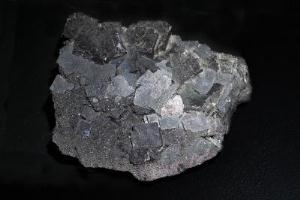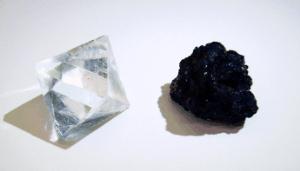

Fluorine is the most reactive chemical element. That is why it is not found in nature in its elemental form, but only in compounds, such as fluorite - that was the accepted scientific doctrine so far.
A special fluorite, the 'fetid fluorite' or 'antozonite', has been the subject of many discussions for nearly 200 years. This mineral emits an intensive odor when crushed.
Now, for the first time, scientists from the Technical University of Munich (TUM) and the Ludwig-Maximilians-University Munich (LMU) have successfully identified natural elemental fluorine in this fluorspar.
They report their results in the international edition of the scientific journal Angewandte Chemie.
Being the most reactive of all chemical elements fluorine calls for extremely careful handling. It is so aggressive that glass laboratory instruments cannot resist it and even bricks burn when exposed to fluorine gas. Yet elemental fluorine has numerous industrial applications including corrosion prevention or fuel tank diffusion barriers and it is used for the production of sulphur hexafluoride, which serves as insulating material in high voltage switches.
Because of its extreme properties, until now chemists were convinced that fluorine cannot occur in nature in its elemental form, but only as a fluoride ion, for instance in minerals such as fluorite (CaF2), also known as fluorspar. A certain variety of it, the so-called "fetid fluorite" or "antozonite" from the "Maria" mine in Woelsendorf in the Upper Palatinate (Germany), has been an object of contention in science for some 200 years. When crushed, it emits an unpleasant, pungent smell.
A number of eminent chemists, among them Friedrich Woehler (1800-1882) and Justus von Liebig (1803-1873), proposed various substances to explain the odor. Over the years, scientists resorted to olfactory tests, chemical analyses and complex mass spectrometer studies - coming to very different conclusions. Next to elemental fluorine, substances like iodine, ozone, phosphorus compounds, arsenic, sulphur, selenium, chlorine, hypochlorous acid and hydrofluorocarbons were made responsible for the smell. Direct evidence that this fluorspar has inclusions of fluorine and that the gas does not form during crushing was lacking hitherto.
Now, finally, a scientific team led by Florian Kraus, head of the Fluorine Chemistry Work Group at the Department of Chemistry of the Technische Universitat München, and by Joern Schmedt auf der Guenne, head of the Emmy-Noether Work Group for Solid State NMR at the Department of Chemistry of the Ludwig-Maximilians-University Munich, have succeeded in directly proving the presence of fluorine in "antozonite" beyond any doubt. Using 19F-NMR spectroscopy, they were able to identify the fluorine "in-situ", i.e. non-destructively in its natural environment, and thereby put an end to the long discussions about the cause for the odor of "stinking fluorspar".
"It is not surprising that chemists doubted the existence of elemental fluorine in fetid fluorite," explain the researchers. "The fact that elemental fluorine and calcium, which would normally react with each other at once, are found here side by side is indeed hard to believe." However, in the case of "antozonite" there are very special conditions: The elemental fluorine is generated through minute uranium inclusions in the mineral, which constantly emit ionizing radiation and thus split the fluorite into calcium and elemental fluorine. The fluorine remains in minute inclusions, separated from the calcium by the non-reactive fluorite and thus retains its elemental form. The ionizing radiation also leads to the formation of calcium clusters, which give "antozonite" its dark color.
Angewandte Chemie press release
Secret of 'Fetid Fluorite' Aired
Elemental fluorine F2 detected for the first time in a natural mineral
Why does "fetid fluorite", a mineral that is found in the Upper Palatinate in Bavaria, Germany, have such an unpleasant sharp smell when it is crushed? Scientists in Munich have now found the solution to this puzzle, not only bringing an end to a controversial discussion that has been going on for about 200 years, but also altering a hard and fast textbook rule. In the journal Angewandte Chemie, the researchers have demonstrated that the stench is caused by elemental fluorine. This unambiguously proves that despite prior assumptions, elemental fluorine does occur in nature.
Elemental fluorine (F2) is an extremely reactive gas that attacks nearly all materials; it even eats away at laboratory glassware. In contrast, chemically bound fluorine atoms in inorganic or organic compounds are - in proper doses - harmless and actually quite useful, whether in fluoride toothpaste, flame retardant materials, or Teflon. It is no wonder that chemists have so far been convinced that fluorine cannot occur in nature in its elemental form, but only as the fluoride ion, for example in minerals like fluorite (CaF2).
One special form of fluorite is found in the "Maria" mine in Wölsendorf in the Upper Palatinate in Germany. The unusual thing about this mineral is its odor, which pricks the nose as soon as this "fetid fluorite" or "antozonite" is crushed. But what causes the smell? Experts have been arguing about this for almost 200 years. A number of important chemists, including Friedrich Wöhler (1800-1882) and Justus von Liebig (1803-1873), discussed possible different substances that may be responsible for the smell. Over the years, elemental fluorine; iodine; ozone; compounds of phosphorus, arsenic, sulfur, and selenium; chlorine; hypochloric acid; and fluoridated hydrocarbons have all been blamed for the stench.
Florian Kraus of the TU Munich, as well as Jörn Schmedt auf der Günne and Martin Mangstl at the Ludwig Maximilians University in Munich have now obtained direct proof: Elemental fluorine is the guilty party that causes the unpleasant odor. By using 19F nuclear magnetic resonance spectroscopy (NMR spectroscopy), they were able to show for the first time that elemental fluorine is contained in "antozonite".
How is this possible for such a reactive gas? The researchers explain that "antozonite" contains a tiny amount of uranium that, together with its radioactive daughter nuclides, constantly releases radiation into the surrounding mineral. This causes fluorite to split into calcium and elemental fluorine, forming the calcium clusters that give "antozonite" its dark purple color. The fluorine is contained in tiny enclaves surrounded by nonreactive fluorite, which shields it from the calcium, allowing it to maintain its elemental form.
About the Author
Dr. Florian Kraus is Assistant Professor for Anorganic Chemistry at the Technical University of Munich (Germany). His research focuses on the chemistry of fluorine.
Further Information:
Jörn Schmedt auf der Günne, Martin Mangstl, Dr. Florian Kraus:
Occurrence of Difluorine F2 in Nature - In Situ Proof and Quantification by NMR Spectroscopy.
In: Angewandte Chemie International Edition; published online 04 July 2012, DOI 10.1002/anie.201203515
Source: Technical University of Munich, Germany
Last update: 15.07.2012
Perma link: https://www.internetchemistry.com/news/2012/jul12/elemental-fluorine-nature.php
More chemistry: index | chemicals | lab equipment | job vacancies | sitemap
Internetchemistry: home | about | contact | imprint | privacy
© 1996 - 2023 Internetchemistry
